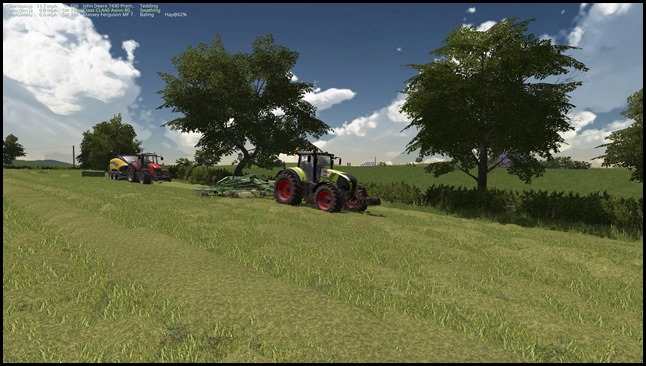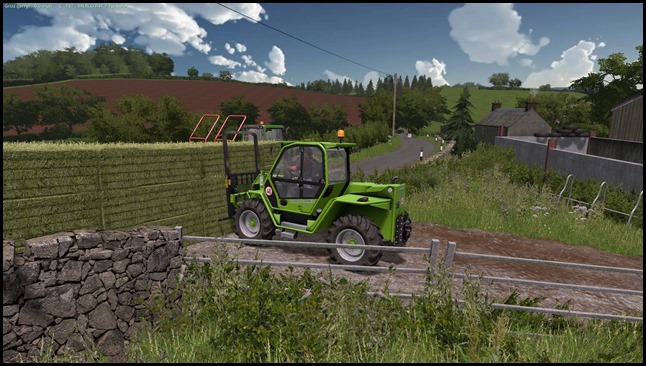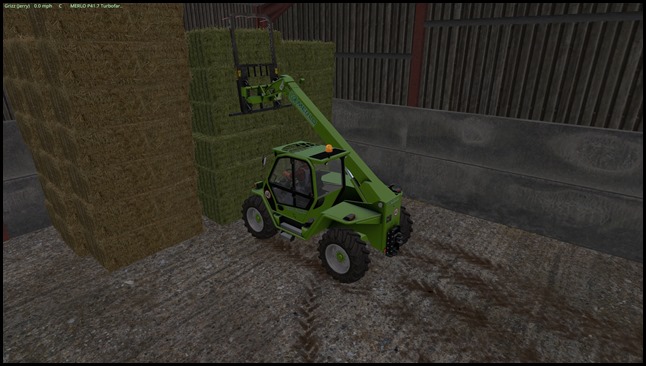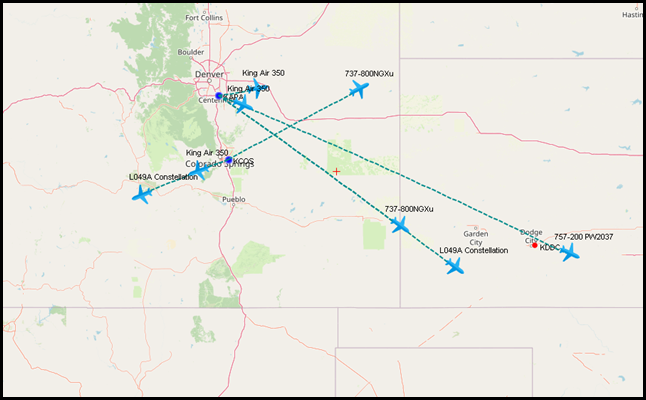December 31, 2020 / admin / 5 Comments
The past few weeks I’ve been playing Farming Simulator 17. No, that’s not a typo….I’ve been playing the FS17 version which was released back in the fall of 2016 and is over four years old. While I enjoy FS19, my enjoyment of the older FS17 version has been rekindled by the updated The Western Shore map by the extremely talented BulletBill. If you are interested in playing The Western Shore for FS17, you can download it from my mod hosting site, SimplySafeMods. Here’s the link.
I was first introduced to this map a little over a year ago. BulletBill had allowed me to download and play the early release of this wonderful map. But since that time, the map has been updated to version 2.0.0.2. The latest version of the map is truly a joy to play and in my opinion, has been modded to play more like a farm sim map should. More about this later.
No Right or Wrong Way
I’ve often said there’s no right or wrong way to enjoy farming simulator. One can choose to play big maps with big equipment (or even small equipment) or one can play smaller maps with smaller equipment. Of course, smaller maps will generally require the use of smaller equipment and The Western Shore is certainly that kind of map.
With mods, one can also choose how to handle various tasks on the farm. As an example, if you don’t want to mess with baling hay or straw, there are mods available which will allow you to store these items in bulk. You can also pair these storage silos with feed mixer mods which will pre-mix your cow or pig feed needs for you. Again, there’s no right or wrong way to play.
My Game Play
As previously mentioned, I’ve been playing FS17 and BulletBill’s The Western Shore. The map was designed with multiplayer in mind, however….it can also be enjoyed in a single player/offline setting as well. The map features multiple farms with each individual farm consisting of a single animal type. But nothing is stopping you from playing multiple farms at the same time. That’s exactly what I’m doing. I’m raising sheep at Strumble Lane and running a small dairy at Bramble Lane. Strumble Lane Farm is my main base of operations (where I live) and I am considering the dairy function as a contract.
Seasons?
Oh yes, I’ve been a HUGE fan of the Seasons mod since it first came out and I’m playing a six game day season setting on The Western Shore. For me, six game days per season is the sweet spot. Three is too short and nine is too long. Six is just right and the custom GEO provides a perfect representation of that wonderful British weather.
Contractors or Helpers? Yep
As with many of my maps, I do use helpers as and when needed. I typically stick with two and that’s what I’m doing here on The Western Shore. While Courseplay certainly has a role in my game play, the Follow-Me mod is proving most helpful especially with grass work.
Lot’s of Grass Work
I love grass work. Running both sheep and cows will certainly require lots of hay and silage. This is some of the most satisfying work that can be done within Farming Simulator (my opinion). Like I said, lots of hay and silage are needed to keep my animals in tip-top shape.

Mowing…lots of mowing is required.

Raking and baling using the Follow-Me Mod.

I do use a few other “assist” type mods on the farm. Including a auto-loading bale trailer. But once offloaded, the bales are handled and stacked manually and as neat as possible.

Today we’re stacking hay in the barn at Bramble Lane Farm.

Still more hay to bring in. But need to take some time and feed the cows.

The fall crops will soon be ready to harvest and that will mean more straw will go into storage and I’ll begin to plan out the jobs that will need to be done over the late fall and winter time here on The Western Shore. I’ll check back in down the road and share some more progress I’m making on this wonderful and fun map.
Thanks for reading. Until next time…
Happy Farming!
Jerry
December 30, 2020 / admin / 0 Comments
Just a little over 10 years ago, I successfully completed an around the world adventure using a Mooney Bravo in FSX. I departed KAPA (my local GA airport in Centennial, Colorado) on 30 September 2010 and arrived back at the same airport on 19 November of the same year. That route took me northeast through Canada over to Greenland etc. you can view this 2010 route here.
The goal for that trip was simply to circumvent the globe the best way possible and in the shortest amount of time. As a matter of fact, my total flying time for that trip was just over 200 hours. It was a lot of fun and with the release of the new Microsoft Flight Simulator 2020, I believe it’s time to do it again. But this time I’m adding a bit more realism. My goal will obviously be to fly around the world, but this adventure will be more than just that. I plan to visit as many countries/continents as possible.
Weather permitting, this adventure will start in the next few days. I say weather permitting because I plan to fly each leg using real world weather. If the weather isn’t suitable for VFR conditions, then I just won’t fly. Having said this, I don’t believe it would be practical to fly northeast or northwest at this time. So I plan to fly southeast from Colorado and spend the next several weeks exploring Central and South America. As we get closer to spring in the northern hemisphere, I’ll then turn and head back north to the US and time my crossing from Canada to Greenland, Iceland etc.
How Long Will This Take?
The short answer, it will take as long as it takes. I’m fairly certain this trip will take much, much longer than my 2010 trip. Actually, perhaps my first goal is to be back in Colorado by the end of 2021. This will allow me an entire year and will prevent me from burning out by doing the same thing day in, day out.
The Aircraft of Choice
Much like my 2010 adventure, I’m also going to be flying the Mooney M20R Ovation. I picked up the Carenado M20R during the Christmas sale and while it pretty much handles like any of the other default aircraft, it’s an enjoyable aircraft to fly. Plus with a 25,000 service ceiling, cruise speed of 242 knots and range of 1,100 nmi it’s the perfect single engine aircraft for this adventure.
Flight Tracking
While I don’t plan to blog about each and every leg of this trip, I will update a flight log and map after each leg so you can follow along with my progress. Every few legs I may write up a blog post discussing the adventure and providing a few screen shots to highlight the trip.
Rules
We don’t need no stinkin rules! LOL Ok, there are a few rules I’ve established for this trip. First, I will be flying all legs in real time (no time compression) and real weather conditions. I will adjust the time of day in the simulator when required. I do plan to fly mostly during daytime hours. After all, MSFS truly has stunning visuals and we’ll want to see all we can as we explore our wonderful world.
Thanks for reading and I hope you’ll enjoy reading about this adventure as much as I will have flying it.
Until next time…
Happy Flying!!!
Jerry
December 23, 2020 / admin / 0 Comments
A few weeks ago I posted about my progress of running Air Hauler 2 in a standalone environment where I was just acting as CEO and directing my AI Pilots here and there hauling cargo from our two Colorado hubs. Since that time, I’ve managed to both grow and also somewhat consolidate the business into a more revenue generating and efficient operating machine.
Size Matters
In the early stages of getting the business off the ground (pun intended), the need for smaller, single pilot aircraft was very much needed and heavily utilized. As the business grew, I began to realize that these smaller aircraft were actually holding me back from the higher paying jobs. While it’s possible to just schedule a King Air and one pilot to fly back and forth between airports until they’ve managed to move all the cargo. This method is also not efficient. So I decided to make a few adjustments to the fleet.
No Layoffs
After having experienced my own layoff earlier this summer from a company I had spent the past 22 years fully dedicated to, I didn’t want this change of business model to impact any of my hired AI. So I set about a plan to train pilots up to the next level of aircraft. But this isn’t as straightforward as one might think. In the perfect world I had hoped I could simply train two of my King Air pilots up to the Boeing 737 and eliminate two King Air aircraft and keep one. But I found one was qualified and one was not. So I took a step back and re-evaluated my staff and operations.
After this re-evaluation effort, I decided I would sell off all three King Air aircraft from the fleet. Of the three pilots impacted by this decision, one would be trained up to the 737 and the other two would be trained up to the Connie. Two of the existing Connie pilots would then undergo training for the 737. Once their training was complete, I would hire a brand new pilot already qualified on the 737. So in reality, this plan is growing our cargo hauling capacity, but also eliminating three aircraft from the fleet. I then leased two Boeing 737-800 aircraft configured for cargo operations.
Even More Growth Opportunities
The shuffling efforts mentioned above, still left me with over $28 million in the bank and only a monthly overhead of $16.9 million. The decision was made to further expand the fleet with another Boeing 757 and the hiring of two additional qualified pilots for that aircraft type. As it stands today, my fleet of cargo aircraft consists of three Connie’s, four 737-800’s and two 757-200’s.

Future Outlook
Looking ahead, the future is bright for GrizzlyBear Cargo. It will be necessary to operate in the current setup for sometime. However, the next logical step will be to introduce an even larger aircraft to the fleet which will greatly extend both the range as well as the cargo hauling capabilities for us. Most likely this will be a Boeing 747. But with that plan in mind, it will probably be necessary to also look to a bigger home base airport. KAPA (Centennial Airport) is my current main base. The runways at KAPA can accommodate our existing fleet, but not a 747. While the secondary base at KCOS (Colorado Springs) can accommodate the 744, most likely we will move our main base (HQ) to KDEN and decide on either keeping KAPA or KCOS as secondary. Time will tell….
I’ll check back in and provide an update in a few weeks. By then I should have made the decision on the new HQ and other operations.
Until next time…
Happy Cargo Hauling!
Jerry
December 14, 2020 / admin / 0 Comments
I purchased Air Hauler 2 a year or two ago when it was in early beta for P3D. I played around with it, but during those early days the application wouldn’t function in a networked environment. So the only time I really could use it was when I was physically in my man-cave and using my main gaming PC. Really at that time my main interest in Air Hauler 2 was in running my own cargo airline empire using AI pilots to do all the work.
At some point between the early release and the present time, the developers of Air Hauler 2 made the application capable of running in a network environment. Meaning, I can run Air Hauler 2 and no longer need to have my main gaming PC running, or at least running all the time. This also means that while I don’t have a lot of time to game at the present moment, I can schedule out the flights in the morning over my first coffee and check their progress throughout the day and afternoon.
The Setup
As previously mentioned, I installed Air Hauler 2 on my laptop. I needed to connect it the first time via across my network just to sync P3D. This is required so you can import the aircraft options you have installed. But this step really is only needed to be done once or in the future if you install additional aircraft into the sim.
The Initial Strategy
As previously stated, I have no desire to use Air Hauler 2 to track my flights and in my cargo airline I’m fulfilling the role of CEO and not a pilot. I started out in “Medium” mode. This gave me $500,000, 50% reputation and a Cessna Caravan which I immediately sold. I took out a bank loan which allowed me to purchase two aircraft with one being a King Air 350 and the second the larger L049A Constellation. I hired three pilots and established my cargo base of operations at Centennial Airport KAPA. I chose KAPA over the larger Denver International as KAPA offered cheaper landing fees and after all, I’m a small cargo airline.
The initial grind was challenging, but fun. I managed to keep the two planes and three pilots busy enough to accumulate a little extra cash. I then leased another King Air and a second Constellation. I set a goal of paying back the bank loan before adding anything additional to the fleet.
Another few days of the grind, I managed to pay back the bank loan and lease a Boeing 737-800 setup for cargo and hired another two pilots with certifications capable of flying the B738. The money was now rolling in hand over fist.
Factories
I setup my first factory at KAPA so I could manufacture cell phones, memory sticks and televisions. I didn’t realize at the time I would also need to manufacture plastics and battery packs. So I had a bit of a delay and had to save enough money to open a second base (Colorado Springs KCOS) where I could take chemicals and produce plastics and batteries to produce battery packs. Once this was setup, I was set to get rolling in my factory operations.
Initially I was moving the completed plastics and battery packs via my own aircraft. But soon started paying for ground transportation between KAPA and KCOS. The cost is minimal and allows my aircraft to do what they do best and that is haul cargo for paying customers.
As It Stands Today
Today, I’ve grown my little operation to a total of 15 pilots and 9 aircraft with a total of 3 King Air 350’s, 3 L049A Constellation’s, 2 Boeing 737-800’s and 1 Boeing 757-200 with two bases and two factories. The total cost for aircraft leases, insurances and base costs approx. $10.7 million and I currently have just over $15.0 million in the bank with no outstanding loans. My next payment for aircraft leases, insurance etc. is due in about two weeks. So the goal for now is to grind out more cargo runs, keep the factories running and producing approx. $1 million every 24 hours. Depending on how hard I work my pilots, the cargo operation brings in approx. $1.5 – $2 million per day. Again, it really just depends on how much I play.

Future Goals
Once this next $10.7 million payment is made, will see about leasing another 757-200. This may or may not replace one of the existing “Connie” aircraft in the fleet or perhaps be yet another addition. I do plan to continue to grow the small cargo airline into something much larger with the addition of a Boeing 777 Freighter and the Queen of the Skies the Boeing 747-800. But we first need to continue crawling before we can run the marathon.
I’ll check back in with you sometime after the new year and provide a progress update. At the present time, I’m finding that leasing aircraft is far better than purchasing. After all, most real world airlines lease versus buy for much the same reason.
Air Hauler 2 is available for Prepar3d, XPlane and now MSFS2020.
Until next time…
Happy Cargo Hauling….
Jerry
December 8, 2020 / admin / 4 Comments
One of the major benefits of P3Dv5 was the integration of Enhanced Atmospherics (EA) and TrueSky. From the very early days of my experiences with P3Dv5, I had issues (both performance and visual quality) with EA enabled. Of course, in the early stages EA was very much beta. But with each P3D update, I optimistically tried EA only to find myself disappointed in the outcome.
Today I’m running the very latest version of Prepar3D v5.1 (with hotfix 1) and while I’m glad to say that performance is no longer an issue with EA, the over visual quality is still absolutely terrible. I’ve read as much as I possible can, watched countless videos and the look with EA enabled is an over exposed, blurry sky with no defined cloud textures.
While I’m running a few extra texture add-ons such as TOGA Projects EnvTex and EnvShade along with ASCA, Reshade, and the Lucas Cavatoni preset, these don’t have any impact (good or bad) to the overall experience with EA enabled in P3D.
I’ve even followed a few steps to ensure my monitor is correctly color balanced (it was already), but double-checked. I’ve also read (can’t remember where) that EA just will not work with a non-4K monitor. However, I believe I’ve debunked this theory when speaking with a few others who have the exact same experience I’m having on 4K setups.
The bottom line (at least for me) is an assumption that Enhanced Atmospherics still just isn’t ready for prime time. Hopefully Lockheed Martin will continue to work through these issues. But for now, I’m enjoying a very stable, well performing P3Dv5.1 HF1 without Enhanced Atmospherics.
Until next time…
Happy Flying!!!
Jerry








